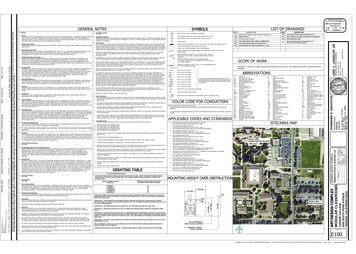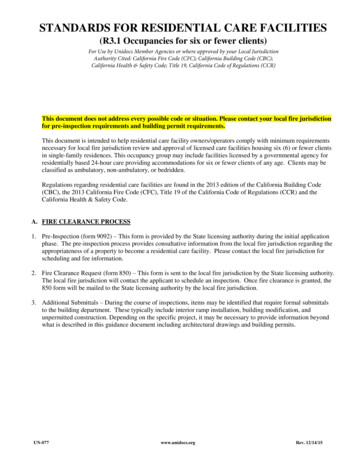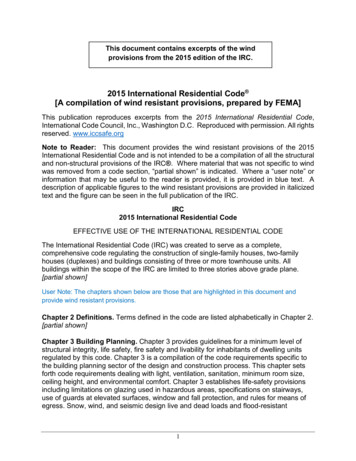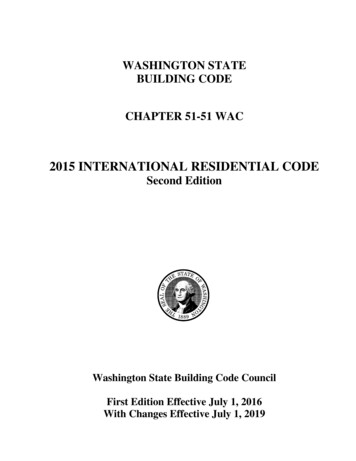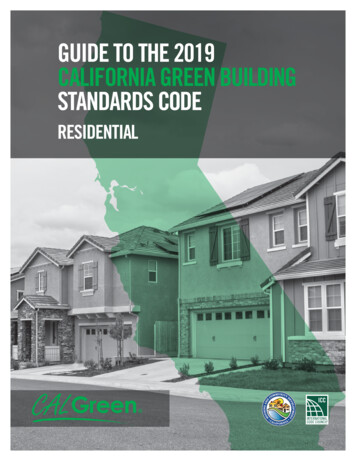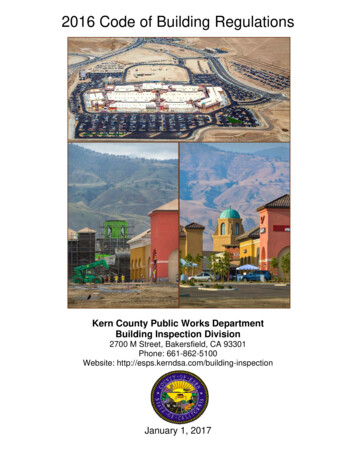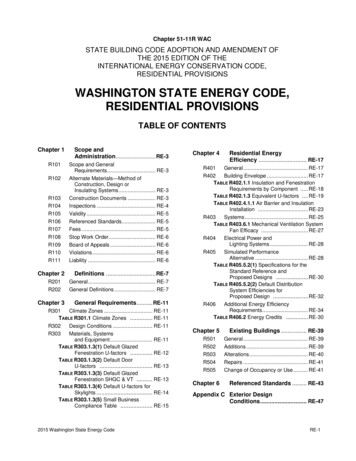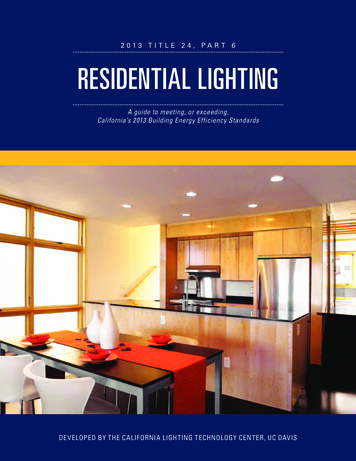
Transcription
"Portions of this publication reproduce excerpts from the 2013 California Mechanical Code, Title 24, Part 4 and 2013 CaliforniaPlumbing Code, Title 24, Part 5, reprinted with the permission of the International Association of Plumbing and MechanicalOfficials. This copyright material and all points or statements in using this material have not been reviewed by IAPMO. Theopinions expressed herein are not representations of fact from IAPMO."Portions of this publication reproduce excerpts from the 2013 California Building Code, Title 24, Part 2, 2013 CaliforniaResidential Code, Title 24, Part 2.5 and the 2012 International Mechanical Code, International Code Council, Inc.,Washington, D.C. Reproduced with permission. All rights reserved." www.iccsafe.orgMechanical CodeCity of San Diego2013 Mechanical Regulations - Proposed Code Changes1. UPDATE THE LIST OF CMC APPENDIX CHAPTERS ADOPTEDNote: Section §148.0105is proposed to be deleted due to relocation to Section129.0404 discussed in the “Construction Permit Procedures” package.Update list of appendix chapters adopted.Text as it would appear in LDC§148.0106 0105Adoption of Appendices to 2010 California MechanicalCode(a)The following Appendix Chapters of the 2010 2013California Mechanical Code not adopted by a State agency asidentified in Section 148.0103 and the adoption matrices of the2010 2013 California Mechanical Code are adopted by the Cityof San Diego:(1) Chapter 1, Part II Administration.(2) Appendix A - Uniform Mechanical Code Standard No. 6-2.(b)The following Appendix Chapters of the 2010 2013 CaliforniaMechanical Code adopted by a State agency as identified in
2013 Mechanical Regulations Code ChangesApril 8, 2015Section 148.0103 and the adoption matrices of the 2010 2013California Mechanical Code are adopted by the City of SanDiego:(1) Appendix A - Uniform Mechanical Code Standard No. 6-2.(2) (1) Appendix B - Procedures to be Followed to Place GasEquipment in Operation.(3) (2) Appendix C - Installation and Testing of Oil (Liquid)Fuel-Fired Equipment.(4) (3) Appendix D - Unit Conversion Tables.Reason:Appendix A was not adopted by any State agency so it will not beadopted. Appendix D will not be adopted since most applicationswill require a registered design professional to design the venting.2. EXISTING MECHANICAL SYSTEMSAdd requirements based on Sections 101.3 for additions and 102.3 in Division II ofthe CMC since the Division is not adopted by the City of San Diego change ofoccupancy and 102.5 for plumbing systems in relocated buildings.Text as it would appear in LDC§148.0108Mechanical Regulations In Existing Buildings.(a)Mechanical systems that are a part of a building or structureundergoing a change in use or occupancy, as defined in theCalifornia Building Code, shall comply with therequirements of the prevailing edition of the CaliforniaMechanical Code applicable to the new use or occupancy.(b)Mechanical systems that are a part of existing buildings orstructures that are to be relocated shall not be required tocomply with the requirements of the prevailing edition ofPage 2
2013 Mechanical Regulations Code ChangesApril 8, 2015the California Mechanical Code applicable to newbuildings if the existing mechanical systems comply withSection 121.0302. Alterations to such mechanical systemsshall comply with the requirements for new mechanicalsystems.Reason:The proposed change aligns the plumbing permit procedures withCh 1 Division II of the California Mechanical Code that is notadopted by the City of San Diego. Section 121.0302 of the LDCaddresses the majority of the regulations in Section 101 and 102 ofthe CMC. However, existing buildings and relocated buildings arenot addressed.3. CLOTHES DRYER TERMINATION IN COMMON SHAFTModify the CMC to include requirements for common shafts used to convey exhaustfrom multiple domestic clothes dryers.Text as it appears in 2013 CMC504.3 Clothes Dryers. Moisture exhaust ducts shall terminate on the outside ofthe building and shall be equipped with a backdraft damper. Screens shall not beinstalled at the duct termination. Ducts for exhausting clothes dryers shall not beconnected or installed with sheet metal screws or other fasteners that willobstruct the flow. Clothes dryer moisture exhaust ducts shall not be connected toa gas vent connector, gas vent, or chimney, and shall serve clothes dryers.Clothes dryer moisture exhaust ducts under positive pressure shall not extendinto or through ducts or plenums.504.3.1 Domestic Clothes Dryers. Where a compartment or space for adomestic clothes dryer is provided, not less than a 4 inch diameter (102 mm)moisture exhaust duct of approved material shall be installed in accordance withthis section and Section 504.0.Where a closet is designed for the installation of a clothes dryer, anopening of not less than 100 square inches (0.065 m2) for makeup air shall beprovided in the door or by other approved means.504.3.1.1 Domestic Dryer Vents. Domestic clothes dryer moisture exhaustducts shall be of metal and shall have smooth interior surfaces.Page 3
2013 Mechanical Regulations Code ChangesApril 8, 2015Exception: Listed clothes dryer transition ducts not more than 6 feet (1829mm) in length shall be permitted to be used in connection with domesticdryer exhausts.Flexible clothes dryer transition ducts shall not be concealed withinconstruction.504.3.1.2 Length Limitation. Unless otherwise permitted or required by thedryer manufacturer's instructions and approved by the Authority HavingJurisdiction, domestic dryer moisture exhaust ducts shall not exceed a totalcombined horizontal and vertical length of 14 feet (4267 mm), including two90 degree (1.57 rad) elbows. A length of 2 feet (610 mm) shall be deductedfor each 90 degree (1.57 rad) elbow in excess of two.Section 504.3.3 “Common exhaust systems for clothes dryers located inmultistory structures”. Where a common multistory duct system is designedand installed to convey exhaust from multiple clothes dryers, the construction ofthe system shall be in accordance with all of the following:(1)(2)(3)(4)(5)(6)(7)(8)(9)(10)(11)The shaft in which the duct is installed shall be constructed and fireresistance rated as required by the California Building Code.Dampers shall be prohibited in the exhaust duct. Penetrations of the shaftand ductwork shall be protected in accordance with Section 717.5.3 of theCalifornia Building Code.Rigid metal ductwork shall be installed within the shaft to convey theexhaust. The ductwork shall be constructed of sheet steel having a minimumthickness of 0.0187 inch (0.4712 mm) (No. 26 gage) and in accordance withSMACNA Duct Construction Standards.The ductwork within the shaft shall be designed and installed withoutoffsets.The exhaust fan motor design shall be in accordance with Section 503.2 ofthe California Mechanical Code.The exhaust fan motor shall be located outside of the airstream.The exhaust fan shall run continuously, and shall be connected to a standbypower source.Exhaust fan operation shall be monitored in an approved location and shallinitiate an audible or visual signal when the fan is not in operation.Makeup air shall be provided for the exhaust system.A cleanout opening shall be located at the base of the shaft to provide accessto the duct to allow for cleaning and inspection. The finished opening shall benot less than 12 inches by 12 inches (305 mm by 305 mm).The common multistory duct system shall serve only clothes dryers and shallbe independent of other exhaust systems.504.3.2 Commercial Clothes Dryers. Commercial dryer exhaust ducts shall be installedin accordance with their listings. The installation of commercial clothes dryer exhaustducts shall comply with the appliance manufacturer's installation instructions.Page 4
2013 Mechanical Regulations Code ChangesApril 8, 2015Text extracted/modified from 2012 IMC504.8 Common exhaust systems for clothes dryers located in multistorystructures. Where a common multistory duct system is designed and installed toconvey exhaust from multiple clothes dryers, the construction of the system shall bein accordance with all of the following:1. The shaft in which the duct is installed shall be constructed and fire-resistancerated as required by the International California Building Code.2. Dampers shall be prohibited in the exhaust duct. Penetrations of the shaft andductwork shall be protected in accordance with Section 607.5.5, Exception 2.3. Rigid metal ductwork shall be installed within the shaft to convey the exhaust.The ductwork shall be constructed of sheet steel having a minimum thickness of0.0187 inch (0.4712 mm) (No. 26 gage) and in accordance with SMACNA DuctConstruction Standards.4. The ductwork within the shaft shall be designed and installed without offsets.5. The exhaust fan motor design shall be in accordance with Section 503.2 of theCalifornia Mechanical Code.6. The exhaust fan motor shall be located outside of the airstream.7. The exhaust fan shall run continuously, and shall be connected to a standbypower source.8. Exhaust fan operation shall be monitored in an approved location and shallinitiate an audible or visual signal when the fan is not in operation.9. Makeup air shall be provided for the exhaust system.10. A cleanout opening shall be located at the base of the shaft to provide access tothe duct to allow for cleaning and inspection. The finished opening shall be notless than 12 inches by 12 inches (305 mm by 305 mm).11. Screens shall not be installed at the termination.12. The common multistory duct system shall serve only clothes dryers and shall beindependent of other exhaust systems.Text as it would appear in LDCPage 5
2013 Mechanical Regulations Code Changes148.0104April 8, 2015Modifications to the 2010 California Building Code Adoptedby the City of San DiegoThe following Sections or Subsections of the 2013CaliforniaMechanical Code are modified by the City of San Diego:(a)§148.01040105Chapter 5, Exhaust Systems; Section 504.3Additions to the 2010 2013 California Mechanical CodeAdopted by the City of San DiegoThe following Sections or Subsections have been added to the2010 2013 California Mechanical Code regulations by the City ofSan Diego: None.(a)§148.0501Chapter 5, Exhaust Systems; Section 504.3.3.Local Modifications and Additions to Chapter 5 “ExhaustSystems” of the 2013 California Mechanical Code(a)Chapter 4 of the 2013 California Mechanical Code isadopted by reference with additions and modificationspursuant to Sections 148.0104 and 148.0105 of the LandDevelopment Code.§ 148.0504 Local Modifications and Additions to Section 504.3“Clothes Dryers” of the California Mechanical Code.(a)Chapter 5 of the 2007 2013 California Mechanical Codehas been adopted without change pursuant to Section148.0104 of the Land Development Code. Section504.3.3 “Common exhaust systems for clothes dryerslocated in multistory structures” is added as follows.Page 6
2013 Mechanical Regulations Code Changes(b)April 8, 2015Where a common multistory duct system is designedand installed to convey exhaust from multiple clothesdryers, the construction of the system shall be inaccordance with all of the following:(1)The shaft in which the duct is installed shall beconstructed and fire-resistance rated as requiredby the California Building Code.(2)Dampers shall be prohibited in the exhaust duct.Penetrations of the shaft and ductwork shall beprotected in accordance with Section 717.5.3 ofthe California Building Code.(3)Rigid metal ductwork shall be installed withinthe shaft to convey the exhaust. The ductworkshall be constructed of sheet steel having aminimum thickness of 0.0187 inch (0.4712 mm)(No. 26 gage) and in accordance with SMACNADuct Construction Standards.(4)The ductwork within the shaft shall be designedand installed without offsets.(5)The exhaust fan motor design shall be inaccordance with Section 503.2 of the CaliforniaMechanical Code.(6)The exhaust fan motor shall be located outside ofthe airstream.(7)The exhaust fan shall run continuously, and shallbe connected to a standby power source.(8)Exhaust fan operation shall be monitored in anapproved location and shall initiate an audible orvisual signal when the fan is not in operation.(9)Makeup air shall be provided for the exhaustsystem.Page 7
2013 Mechanical Regulations Code Changes(10)April 8, 2015A cleanout opening shall be located at the base ofthe shaft to provide access to the duct to allowfor cleaning and inspection. The finished openingshall be not less than 12 inches by 12 inches(305 mm by 305 mm).(11)The common multistory duct system shall serveonly clothes dryers and shall be independent ofother exhaust systems.Reason: When California Decided to adopt the Uniform Mechanical code as abasis for the 2013 California Mechanical code in lieu of the 2012 InternationalMechanical Code, regulations for dryer ducts locate in a common shaft typicallyfound in multi-family housing were not adopted. Section 504.8 of the IMC iscoordinated with Section 717.5.3 Exception # 5 of the 2013 California BuildingCode. The amendment addresses provisions for cleaning the common shaft andpreventing the transfer of smoke to other stories due to omission of fire dampersand smoke dampers. Item # 11 from the IMC is not adopted since the CMC inSection 504.3 addresses the requirement. CMC and IMC Section 503.2 includethe same requirements to limit the clogging of fans. Item # 3 of the IMC isadopted and does not conflict with Section 905 of the CMC and includes specificrequirements to ensure that ductwork concealed within the common shaft do notfail prematurely and requires rigid ducting.3/1/15 7:39 PMPage 8
2013 Mechanical Regulations Code Changes April 8, 2015 Page 6 148.0104 Modifications to the 2010 California Building Code Adopted by the City of San Diego The following Sections or Subsections of the 2013California Mechanical Code are modified by the City of San Diego: (a) Chapter 5, Exhaust Systems; Section 504.3
